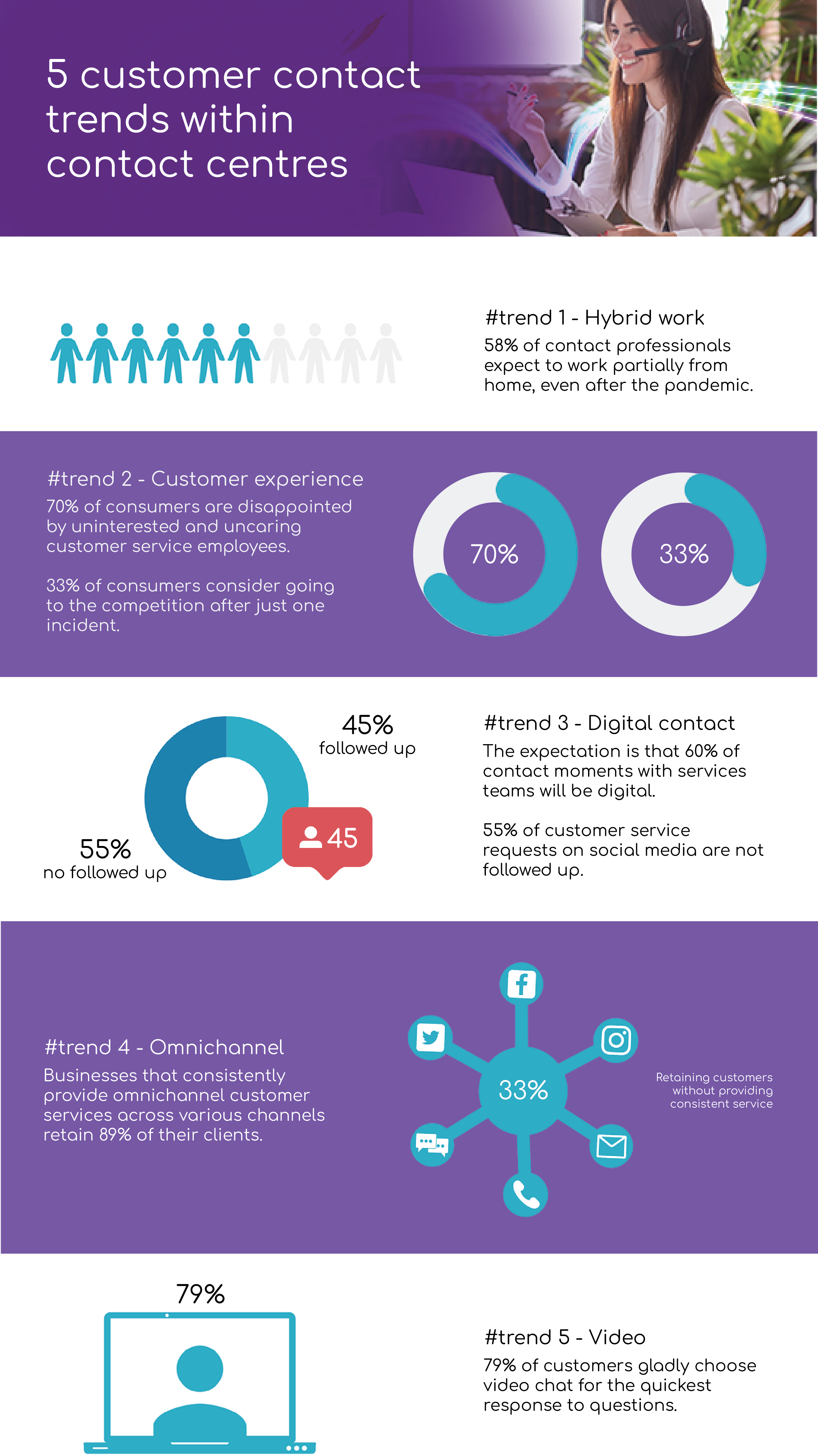As an organisation, you want to keep up with the times, and you want to make sure you are accessible to both your customers and other key stakeholders. Change happens quickly, and what is successful today may be useless tomorrow. What is trending now is the expectation of best service and personal contact. Customers are even willing to spend more to get these expectations met. Customer expectations are constantly changing. How can you keep up with them? We have highlighted 5 trends for you in an infographic to help you stay on top of the crucial developments in customer contact.

Trend 1 – Hybrid work
Hybrid work is the new normal. Many companies are joining in, and so are contact centres. A study by TNO, among others, shows that the Dutch want to continue working from home at least one day a week even after the pandemic. An industry study shows that 58% of contact professionals are thinking of continuing to work partly from home even after the pandemic. And that means your contact centre will no longer be in a single location, but it will be spread out.
This can pose a problem for your organisation's reachability, because who will answer the office phone if everyone decides to work from home? How can a customer service employee ask a colleague for assistance with a particular customer's problem when the colleague in question is not in the office? How do you ensure that queues on the phone don't grow too long when there are only a few employees available in the office to answer them? And how do you avoid having to tell the customer via an automated response that 'the waiting time is approximately 5 minutes' or 'you are the sixth caller in the queue'? Can you relate to these situations?
What if this situation could be managed more efficiently? For example, by transferring incoming calls to the employees who are working at home? Read more about this possibility in our blog: 3 tips for optimal customer contact within your customer service department.
Trend 2 – Customer Experience
You probably hear about it all the time, but there's no getting around it: Customer Experience is becoming the new business strategy. Customer experience has namely become more important in recent years. COVID-19 certainly contributed to this, because personal contact in times of crisis is important. Social needs are not included as the third step in Maslow's pyramid for nothing.
A research report by Zendesk shows that 75% of customers are willing to spend more with businesses that offer a good customer experience. According to Steam Connect's trend report, 70% of consumers are disappointed when customer service agents are uninterested and indifferent. 33% of customers even consider switching to a competitor after just one incident.
Perhaps you yourself have had a disappointing customer service experience. My experience was with a postal delivery service. I had ordered a parcel from a shop, and had requested for it to be delivered to my home address. The shop's website said: orders placed today before 23:00 are delivered the next day. I had placed my order well before 23:00. As you can probably guess, the parcel was not there the next day, but it was ready to be delivered by the delivery service. I chose to call the delivery service's customer service and ask about the status of my package. After a friendly conversation with a lady, she promised me on the phone that it would in fact be delivered the next day. To my disappointment, this was not the case.
For me, this was a disappointing experience that I will remember better than a positive experience. Psychologists call this phenomenon negativity bias. Negative experiences have a far greater effect on us than positive experiences.
Trend 3 – Digital contact
Due to the pandemic, face-to-face contact was difficult. As a result, people started contacting customer service digitally. For example, queries started to come in via Facebook Messenger, WhatsApp, live chat, or Instagram DMs. Gartner predicts that 60% of contact moments will be digital by 2023.
What is striking is that 55% of customer service requests via social media are not followed up. That would mean that only 45% of your (potential) customers get answers to the questions they ask. Have you experienced this as a customer before? Do you recognise the frustrating feeling of having to chase after an answer yourself? It is good to include different digital channels in your omnichannel customer contact strategy, provided you make sure everyone is assisted. To keep an overview of incoming requests, you can use Pegamento's Contact Centre solution. This allows you to send and receive messages via a single platform.
Trend 4 - Omnichannel
Trend 3 ties in well with the next trend, which is that customers want to contact your organisation via an increasing number of channels. Customers nowadays expect companies to provide service on the channels that customers prefer. In addition, experts expect customer experience to become more important than product and price. Essentially, you therefore need to offer a seamless customer journey to your customers. Let's go back to your own experience for a moment. How much do you enjoy being helped quickly? Without you being sent from one agent to another? This is why we are more likely to choose to do business with an organisation that has assisted us efficiently in the past.
To ensure the optimal customer journey during customer interaction, channels must merge seamlessly. Customers must also be able to switch from one channel to another without having a different experience. To achieve this, omnichannel customer service must be delivered consistently. A study shows that companies that consistently provide omnichannel customer services across channels retain 89% of their customers. Companies that do not do so retain only 33% of customers.
Trend 5 - Video
The pandemic is responsible for promoting a range of customer contact trends. This goes for video, too. Physical contact was obviously reduced during the pandemic, and working from home was common. Instead of physical face-to-face contact, we started using video calls in addition to other digital channels. Businesses use video calls not only for internal meetings with colleagues and partners - they are also making increased use of video calling with customers. Customers have found that video calling is the fastest way to get answers to their questions - faster than other contact channels. 79% of customers therefore prefer video chat. It creates more trust and fosters a more personal connection between the organisation and the customer.
Video enables companies to harness technology without losing the human touch. Screensharing is an emerging method for video-based customer service. Here, the agent takes over the screen on the customer's device to solve a problem. It is now even possible to view a problem through the customer's camera, as with Video Assistant.
For example, a customer's boiler is malfunctioning. In this type of situation, it is sometimes difficult to identify the problem and its cause over the phone or via chat. There is noise on the line as the employee has to decipher what the customer describes verbally. If customer service can see what the customer is talking about via the customer's smartphone camera, the service employee can immediately see the type of boiler and the problem. The problem can then be solved fully and efficiently. This saves travel time, service time, and unnecessary visits.
View the customer contact trends in PDF, and get access to more tips!
Download the 5 customer contact trends in contact centres in PDF for free and get access to tips on how to respond to these trends. It's also easy to share with your colleagues.
Is your customer service ready to go for 2022?

